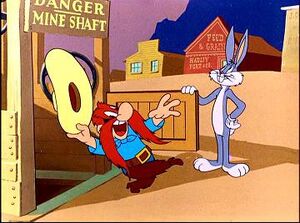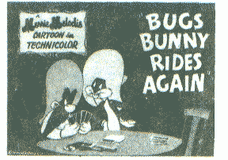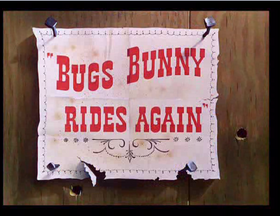(Adding categories) Tag: categoryselect |
LevenThumps (talk | contribs) No edit summary Tag: sourceedit |
||
| Line 48: | Line 48: | ||
==Availability== |
==Availability== |
||
| − | * |
+ | *DVD - [[Looney Tunes Golden Collection: Volume 2]], Disc One |
==External Links== |
==External Links== |
||
Revision as of 18:06, 6 October 2016
Deprecated
We have moved to portable infoboxes using the new Template:Shorts
Please do not use this template anymore. It is left here for reference purposes.
| Bugs Bunny Rides Again | |||||||||||||||||||||||||||||||||||||||||||||
| |||||||||||||||||||||||||||||||||||||||||||||
|

Bugs Bunny Rides Again is a 1947 Merrie Melodies short, released in 1948, directed by Friz Freleng, and written by Tedd Pierce and Michael Maltese. Voice characterizations are performed by Mel Blanc. The cartoon features Bugs Bunny and Yosemite Sam.
This is the next-to-last Bugs Bunny release in the a.a.p. package, with the last such cartoon being Haredevil Hare - also the overall latest-released WB cartoon in the a.a.p. package. This is also the first cartoon to use COLOR BY TECHNICOLOR instead of IN TECHNICOLOR, but shortly changed to Color By TECHNICOLOR starting with Haredevil Hare.
Title
The title is a typical Western reference, as in "The Lone Ranger rides again", and also suggests a reference to the 1940 Jack Benny comedy, Buck Benny Rides Again.
Synopsis
After opening credits underscored by the William Tell Overture (as with The Lone Ranger), the music segués into a lively instrumental of "Cheyenne" as the action begins. The opening scene features a typical Old West frontier town with the self-contradictory name of Rising Gorge. Bullets are firing from every window across the street into every other window across the street. A hail of bullets flies down one street until a stop signal turns red and the bullets hover in mid-air while a

Lobby Card
second hail of bullets shoot by on the perpendicular street. The light changes back and just as the first hail of bullets is about to start, a lone bullet "runs the red light" at even higher speed, holding up the first stream. After it passes, the first hail continues.
The scene then cuts to the Gunshot Saloon with the slogan of 'Come in a get a slug'. Inside, two men are standing at a bar. One man is about to drink a shot of whiskey; the second man takes out his gun and shoots the first man. The first man throws his glass into the air and the second man catches it. A scream is heard and Yosemite Sam enters the bar. All of the patrons are afraid of Sam, yelling his name in terror while the underscore plays stereotypical "villain music". Sam says, "Yeah, Yosemite Sam. The roughest, toughest, he-man stuffest hombre whose ever crossed the Rio Grande... And I don't mean Mahatma Gandhi! (See "Censorship" below for more information about this line.) Now all of you skunks clear out of here!" After firing his guns, all the patrons run out, followed by a real skunk who retorts, "My, weren't there a lot of skunks in here?" Sam turns around to see a man trying to sneak out. Sam fires his guns at the man, who then turns into a firing range walking dummy, making a "ding" every time he is hit, with a score board above keeping tally. After that, Sam asks, "Be there any livin' varmint who aims to try to tame me?" Spying Bugs Bunny, he asks again, "Well, be there?"
No one dares to challenge Yosemite Sam except Bugs, sporting a cowboy hat and rolling a cigarette. After a brief silence, Bugs replies ... "I aims ta ..." Sam declares "this town ain't big enough for the both of us!" Bugs tries to rectify that by running off-screen and, to sound effects of hammers and saws, quickly constructs a background of modern skyscrapers in the town, but "it's still not big enough!" They square off in a variety of disciplines, such as dancing. In the time-honored western cliché, Sam orders Bugs to "Dance!" while firing at his feet. Bugs grabs a cane and straw hat from off-screen, and goes into the same vaudeville soft shoe routine he first exhibited in Stage Door Cartoon (in which a prototype of Sam appeared), then says "Take it, Sam!" The diminutive villain, although startled initially, quickly breaks (rather expertly) into the same dance, and is tricked into dancing into an open mine shaft (nearly getting hurt in the process).
When Sam returns to the surface, Bugs dares him to cross a line drawn with his foot. "OK, I'm a-steppin'!" Bugs continues this schtick all the way out of town to the edge of a cliff, where the unobservant Sam steps over the line and plummets toward the ground far below. (This gag would be recycled in High Diving Hare.) Suddenly stricken with guilt, the speedy hare dashes down a roadway, beats Sam to the ground and lays down a mattress, telling the audience, "Ya know, sometimes me conscience kind-a bodders me ... but not this time!" as he pulls away the mattress. Sam smashes into the ground (off-screen) and the already pint-sized bandit has been vertically flattened to a hat with legs, but he still comes up firing.
A horseback chase scene ensues, to the tune of the William Tell Overture, as the two ride on horses that are proportional to their own sizes (or lack thereof). Bugs leads Sam into a tunnel, and again showing extraordinary construction talents, has time to don a painter's cap and build a brick wall at the other end, which Sam smacks into. After more chasing, Bugs stops the chase and points out that they are getting nowhere and are right back where they began ("Hey, wait a minute, Sam! We ain't gettin' nowheres! We're right back where we started!"), and Sam agrees.
The two decide to settle their differences by playing cards, with the loser being forced to leave town ("Gin rummy's mah game, Sam"). Sam tells Bugs to "cut the cards", which he does using a meat cleaver, a joke previously seen in a Harpo Marx gag in the 1932 film Horse Feathers, a Curly Howard gag in 1936's Ants in the Pantry - and probably a lot older than that. With a new deck, Bugs tricks Sam into playing a card that gives Bugs the win {"GIN! You lose!!"}. Bugs tries to get Sam to take the train out of town, but when the passenger car is revealed to be full of swimsuit-clad women headed on the Miami Special, Bugs fights with Sam to board the train.
Bugs prevails as usual. In the final shot, he leans out the train window, his face covered with lipstick from kisses, and hollers a line similar to one from Hare Trigger: "So long, Sammy, see ya in Miami!"
Trivia
The 1947-48 dubbed ending card is said to come from this cartoon as the dubbed LT card came from Haredevil Hare.
Censorship
- On The WB, the beginning gun- and bullet-related gags in the beginning of the short are cut: the bullets stopping and proceeding at traffic lights, one cowboy shooting another and then drinking his beer as he drops dead, and Sam shooting at a cowboy like he would fire a gun at a duck in a shooting gallery. Also cut on the WB version is Bugs rolling a cigarette when Sam challenges the cowboys to fight him.
- In the original version, Yosemite Sam's intro line when he enters the saloon is, "Yeah, Yosemite Sam. The roughest, toughest, he-man-stuffest hombre to ever cross the Rio Grande. And I ain't no Mahatma Ghandi!" Around the time the short became a reissue Blue Ribbon Merrie Melodie, Ghandi was assassinated, so the last part of the line ("And I ain't no Mahatma Ghandi") was changed to "And I ain't no namby-pamby". The "namby pamby" version is the version that airs frequently on TV and in home media releases, including the Looney Tunes Golden Collection: Volume 2, though the original version with the "And I ain't no Mahatma Ghandi" line still exists.
- Cartoon Network's Arabia channel cuts out the shot near the end of the interior of the Miami Express Train, which features beautiful women in bathing suits.
Availability
- DVD - Looney Tunes Golden Collection: Volume 2, Disc One
External Links
Bugs Bunny Rides Again at SuperCartoons.net
Bugs Bunny Rides Again at B99.TV
also see the List of Bugs Bunny cartoons

